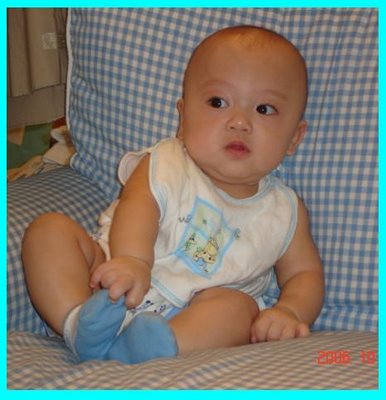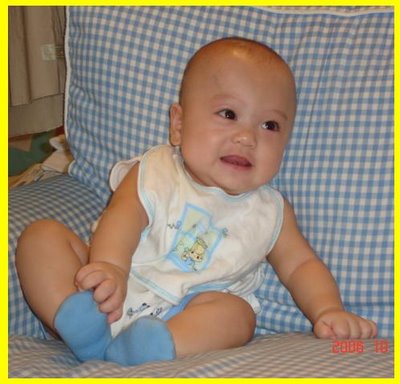I'M HERE AT KAMISETA
 Around 6 months of age your baby’s iron stores will become depleted and you should be introducing foods rich in iron. Start with an iron-fortified infant rice cereal. Rice cereal is the food least likely to cause an allergic reaction. After about a week, you can move on to other cereals such as barley or oats. Feed cereal after breastfeeding or formula feeding. Once things are going well with cereal, you can begin to add other foods such as vegetables and fruit. Offer them separately. Begin with pureed vegetables, like sweet potatoes, squash or peas and fruit like apples, peaches or pears. They should be smooth and easy to chew and swallow.
Around 6 months of age your baby’s iron stores will become depleted and you should be introducing foods rich in iron. Start with an iron-fortified infant rice cereal. Rice cereal is the food least likely to cause an allergic reaction. After about a week, you can move on to other cereals such as barley or oats. Feed cereal after breastfeeding or formula feeding. Once things are going well with cereal, you can begin to add other foods such as vegetables and fruit. Offer them separately. Begin with pureed vegetables, like sweet potatoes, squash or peas and fruit like apples, peaches or pears. They should be smooth and easy to chew and swallow.Remember: Breast milk or infant formula should remain the main food for the first year.
Cautions!
Do not use honey until 1 year to prevent botulism (a form of food poisoning). Do not use egg whites until 1 year to minimize any possible allergic reaction (but egg yolks are okay at 6 months). Do not use raw eggs. To prevent salmonella poisoning cook all eggs well. Do not add sugar or salt to your baby's food. Instead, let him enjoy the natural tastes of food.
If warming baby food, stir and test before feeding to make sure it is not too hot.

Using a cup
When your baby is about 6 to 9 months old, he may be ready to try drinking from a cup. Start with a covered cup with a spout. Give him time to master this new skill. Then you can give him a regular cup to try.
Lots of variety
Try to give him as much variety in his diet as you can to help him form good eating habits. Offer lots of different flavours and a variety of interesting colors and shapes. There probably will be some new foods that he seems not to like. Be sure to continue offering them to him. He may grow to like them.
A lifetime of healthy eating. As you help your little one make the transition to solids, you are also helping him form good eating habits. So choose carefully the foods you feed him. Don't forget that children are natural mimics. You'll want to be a good role model and eat your greens, too. Try to monitor your baby's eating habits without setting too many limitations. To help yourself stay even-keeled, talk to your doctor about the normal course of growth. So you know what kind of ups and downs to expect. Don't connect food to approval or comfort, or you could establish a pattern of emotional eating that will last for years to come. Restricting food too much can cause a child to become nervous about its availability and to overeat.

At six months your baby may:
Sensory / Intellectualbegin to use subtle hand and arm gestures to communicate
Languagesit by herself
Social /Emotionalstart mimicking your behaviour
Learning to Communicate
Amazingly, this month your baby may reach and gesture with her hands. It might be her way of imitating you or trying to tell you something. But you probably won't notice it. Her communication skills need lots of work. You're not used to having a baby who says "Give me", even if it's only with her hands.
Watch your six-month-old closely. You'll see she sometimes tries to use gestures, body language and eye contact to get her point across. She will also start babbling this month. By paying closer attention to adult speech, she is able to make sentence-like strings of vowels and consonants. It's up to you to guess what she means when she says "Ba ba ba" or "Da la da la."
Sitting Up
Sitting up takes a combination of strength, balance and coordination. Your baby will probably start with a tripod pose. That means she'll keep her hands on the floor between her legs. Gradually, she'll learn to sit up straight and let go of the floor. By the end of the month, she'll actually play in this position.
Monkey See, Monkey Do
At six months, babies begin to imitate others. Your baby wants to be like you. Open your mouth and your little monkey will open hers, too. Bang a toy, shake a rattle, splash the bath water, and with a little encouragement, she'll delight in following your lead.

At six months, babies begin the steps towards mastering some major skills: from sitting up, to crawling and standing. All this mobility and coordination will bring a sense of independence, and some frustration.
Build on your baby's more developed physical control by sitting him up, unsupported. Surround him with pillows to cushion his tumbles and rolls. Of course, always keep an eye on him.
Lay your baby on his stomach and lift his legs a few inches off the floor. Encourage him to push his upper body off the floor with his arms.
Sing nursery rhymes pronouncing the words clearly, and varying the loudness of your voice. Rhymes help babies build up their sound repertoires and early reading readiness.
Clap your baby's hands together while you sing to him.
Stand where your baby can see you, and tell him you're going to pick him up. Hold out your arms. When he smiles, coos, or reaches for you, pick him up.




» Post a Comment